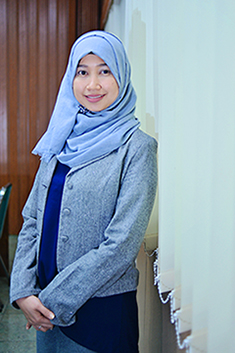Antioxidant Properties of Various Yacon Leaf Water Extracts and Physicochemical Profile of Decoction During Refrigerated Storage
Downloads
Background: Yacon (Smallanthus sonchifolius (Poepp.) H.Rob.) leaves show promising antioxidant properties, and have traditionally been used for diabetes management in Baturraden, Banyumas, Central Java, Indonesia. This study evaluated the effects of traditional extraction methods and crude drug-to-solvent ratios on the content and activity of antioxidants and physicochemical properties of yacon leaf water extracts during storage. Methods: Crude drugs were extracted by infusion, short-time decoction, and longer-time decoction at ratios of 1:10, 1:20, and 1:100 (w/v). Antioxidant content was analyzed using standard total flavonoid content (TFC) and total phenolic content (TPC). The antioxidant activity was evaluated using 2,2-diphenyl-1-picrylhydrazyl (DPPH) scavenging activity and ferric-reducing antioxidant power (FRAP) assays. Yacon leaf water extracts at a ratio of 1:20 (w/v) were stored in tightly closed bottles at 4±2°C for 26 days. The organoleptic characteristics, color, pH, TFC, TPC, and DPPH scavenging activity were evaluated on days 0,1, 3, 6, 12, 18, and 26. Results: The different methods and crude drug-to-water ratios generated different antioxidant activities and contents of the yacon extracts. Yacon leaf decoction for 15 min in a ratio of 1:20 (w/v) produced extract with the best scavenging activity (450.27±5.48 mM Trolox equivalent (TE)/100 g dry weight (DW)), TFC (6.43±0.18 mg Quercetin equivalent (QE)/g DW), and TPC (3.91±0.04 mg gallic acid equivalent (GAE)/g DW). The yacon leaf decoction started to undergo aroma and PH changes on days 3 and 6, respectively. On day 12, the TFC, TPC, and DPPH SA of yacon leaf decoction remained 93.93±3.70, 96.52±1.81, and 89.99±0.91% of the freshly prepared extract, respectively. Conclusion: Our results suggest that extraction using the decoction method for 15 min at a water-to-crude drug ratio of 1:20 (w/v) generated an extract with the best antioxidant profile, which chemically started to change on day 12 during refrigerated storage.
Abubakar, A.R. & Haque, M. (2020). Preparation of medicinal plants: basic extraction and fractionation procedures for experimental purposes. Journal of Pharmacy and Bioallied Sciences; 12; 1–10. doi: 10.4103/jpbs.JPBS_175_19.
Aligita, W., Susilawati, E., Sukmawati, I.K., Holidayanti, L. & Riswanti, J. (2018). Antidiabetic activities of Muntingia calabura L. leaves water extract in type 2 diabetes mellitus animal models. Indonesian Biomedical Journal; 10; 165–70. doi: 10.18585/inabj.v10i2.405.
Checkouri, E., Reignier, F., Silva, C.R.-D. & Meilhac, O. (2022).. Evaluation of polyphenol content and antioxidant capacity of aqueous extracts from eight medicinal plants from Reunion Island: protection against oxidative stress in red blood cells and preadipocytes. Antioxidants (Basel); 9; 959. doi: 10.3390/antiox9100959.
Do, T.H., Truong, H.B. & Nguyen, H.C. (2020). Optimization of extraction of phenolic compounds from Ocimum basilicum leaves and evaluation of their antioxidant activity. Pharmaceutical Chemistry Journal; 54; 162–169. doi: 10.1007/s11094-020-02181-3.
Dobros, N., Zawada, K. & Paradowska, K. (2022). Phytochemical profile and antioxidant activity of Lavandula angustifolia and Lavandula x intermedia cultivars extracted with different methods. Antioxidants (Basel); 11; 711. doi: 10.3390/antiox11040711.
Gajic, I.S., Savic, I., Boskov, I., Žerajić, S., Markovic, I. & Gajic, D. (2019). Optimization of ultrasound-assisted extraction of phenolic compounds from black locust (Robiniae pseudoacaciae) flowers and comparison with conventional methods. Antioxidants; 8; 248. doi: 10.3390/antiox8080248.
Ghafar, F., Nazrin, T.N.N.T., Salleh, M.R.M., Had, N.N., Ahmad, N., Hamzah, A.A., Yusof, Z.A.M., Azman, I.N., (2017). Total phenolic content and total flavonoid content in Moringa oleifera seed. Heritage Science; 1; 23–25. doi: 10.26480/gws.01.2017.23.25.
Hartanti, D., Charisma, S.L., Agustina, W., Sary, R.D., Putri, D.A. & Hamad, A. (2022). The in-vitro antioxidant properties of crude drugs traditionally used for diabetes management in Northern Banyumas. Traditional Medicine Journal; 27; 199–209. doi: 10.22146/mot.76958.
Hartanti, D., Chatsumpun, N., Sa-ngiamsuntorn, K., Supharattanasitthi, W., Kitphati, W. & Peungvicha, P. (2023). The physicochemical properties, antioxidant and antidiabetic activities, and hepatic safety profile of an Indonesian antidiabetic polyherbal formulation. Indonesian Journal of Pharmacy; 34; 65–78. doi: 10.22146/ijp.3243.
Hwang, C.-C., Chien, H.-I., Lee, Y.-C., Lin, C.-S., Hsiao, Y.-T., Kuo, C.-H., Yen, F.-L., Tsai, Y.-H., (2023). Effect of high-pressure processing on the qualities of carrot juice during cold storage. Foods; 12; 3107. doi: 10.3390/foods12163107.
Indonesian MoH, (2017). Indonesia Herbal Pharmacopeia, 2nd ed. Minister of Health, Jakarta.
Ioannou, I., Chekir, L. & Ghoul, M. (2020). Effect of heat treatment and light exposure on the antioxidant activity of flavonoids. Processes; 8; 1078. doi: 10.3390/pr8091078.
Jovanović, M.S., Krgović, N., Živković, J., Stević, T., Zdunić, G., Bigović, D. & Šavikin, K. (2022). Ultrasound-assisted natural deep eutectic solvents extraction of bilberry anthocyanins: optimization, bioactivities, and storage stability. Plants (Basel); 11; 2680. doi: 10.3390/plants11202680.
Khajehei, F., Merkt, N., Claupein, W. & Graeff-Hoenninger, S. (2018). Yacon (Smallanthus sonchifolius Poepp. & Endl.) as a novel source of health promoting compounds: antioxidant activity, phytochemicals and sugar content in flesh, peel, and whole tubers of seven cultivars. Molecules; 23; 278. doi: 10.3390/molecules23020278.
Khajehei, F., Niakousari, M., Damyeh, M.S., Merkt, N., Claupein, W. & Graeff-Hoenninger, S. (2017). Impact of ohmic-assisted decoction on bioactive components extracted from yacon (Smallanthus sonchifolius Poepp.) leaves: comparison with conventional decoction. Molecules; 22; 2043. doi: 10.3390/molecules22122043.
Lachkar, N., Lamchouri, F., Bouabid, K., Boulfia, M., Senhaji, S., Stitou, M. & Toufik, H. (2021). Mineral composition, phenolic content, and in vitro antidiabetic and antioxidant properties of aqueous and organic extracts of Haloxylon scoparium aerial parts. Evidence-Based Complementary and Alternative Medicines; 2021; 9011168. doi: 10.1155/2021/9011168.
Padilla-González, G.F., Amrehn, E., Frey, M., Gómez-Zeledón, J., Kaa, A., da Costa, F.B. & Spring, O. (2020). Metabolomic and gene expression studies reveal the diversity, distribution and spatial regulation of the specialized metabolism of yacón (Smallanthus sonchifolius, Asteraceae). International Journal of Molecular Sciences; 21; 4555. doi: 10.3390/ijms21124555.
Petrović, M., Veljović, S., Tomić, N., Zlatanović, S., Tosti, T., Vukosavljević, P. & Gorjanović, S. (2021). Formulation of novel liqueurs from juice industry waste: consumer acceptance, phenolic profile and preliminary monitoring of antioxidant activity and colour changes during storage. Food Technology and Biotechnology; 59; 282–294. doi: 10.17113/ftb.59.03.21.6759.
Predescu, N.C., Papuc, C., Nicorescu, V., Gajaila, I., Petcu, G.V., Petcu, C.D., Stefan, G., Goran, G.V., Petcu, C.D. & Stefan, G. (2016). The influence of solid-to-solvent ratio and extraction method on total phenolic content, flavonoid content and antioxidant properties of some ethanolic plant extracts. Revista de Chimie; 67; 1922–1927.
Prommachart, R., Belem, T.S., Uriyapongson, S., Rayas-Duarte, P., Uriyapongson, J. & Ramanathan, R. (2020). The effect of black rice water extract on surface color, lipid oxidation, microbial growth, and antioxidant activity of beef patties during chilled storage. Meat Science; 164; 108091. doi: 10.1016/j.meatsci.2020.108091.
Rusli, R.K., Mahata, M.E., Yuniza, A., Zurmiati, Z., Reski, S., Hidayat, C., Hilmi, M. & Mutia, R. (2024). Optimization of solvent and extraction time on secondary metabolite content of mangosteen leaf (Garcinia mangostana L.) as a feed additive candidate on poultry. Journal of Advanced Veterinary Research; 11; 139–145. doi: 10.5455/javar.2024.k758.
Russo, D., Malafronte, N., Frescura, D., Imbrenda, G., Faraone, I., Milella, L., Fernandez, E. & de-Tommas, N. (2015). Antioxidant activities and quali-quantitative analysis of different Smallanthus sonchifolius [(Poepp. and Endl.) H. Robinson] landrace extracts. Natural Product Research; 29; 1673–1677. doi: 10.1080/14786419.2014.990906.
Russo, Daniela, Valentão, P., Andrade, P.B., Fernandez, E.C. & Milella, L. (2015). Evaluation of antioxidant, antidiabetic and anticholinesterase activities of Smallanthus sonchifolius landraces and correlation with their phytochemical profiles. International Journal of Molecular Sciences; 16; 17696–17718. doi: 10.3390/ijms160817696.
Salin, N.S.M., Saad, W.M.M., Razak, H.R.A. & Salim, F. (2022). Effect of storage temperatures on physico-chemicals, phytochemicals and antioxidant properties of watermelon juice (Citrullus lanatus). Metabolites; 12; 75. doi: 10.3390/metabo12010075.
Santos-Sánchez, N.F., Salas-Coronado, R., Villanueva-Cañongo, C. & Hernández-Carlos, B. (2019). Antioxidant compounds and their antioxidant mechanism In: Shalaby, E. (ed.), Antioxidant; 1–28. Vienna: Intech Open.
Silva, A.M., Pinto, D., Fernandes, I., Albuquerque, T.G., Costa, H.S., Freitas, V., Rodrigues, F. & Oliveira, M.B.P.P. (2019). Infusions and decoctions of dehydrated fruits of Actinidia arguta and Actinidia deliciosa: bioactivity, radical scavenging activity and effects on cells viability. Food Chemistry; 289; 625–634. doi: 10.1016/j.foodchem.2019.03.105.
Simamora, A., Santoso, A.W., Rahayu, I. & Timotius, K.H. (2020). Enzyme inhibitory, antioxidant, and antibacterial activities of ethanol fruit extract of Muntingia calabura Linn. Journal of Herbmed Pharmacology; 9; 346–354. doi: 10.34172/jhp.2020.44.
Sujarwo, W., Prihardhyanto, A., Savo, V., Guarrera, P.M. & Caneva, G. (2015). Ethnobotanical study of Loloh: traditional herbal drinks from Bali (Indonesia). Journal of Ethnopharmacology; 169; 34–48. doi: 10.1016/j.jep.2015.03.079.
Sulaiman, I.S.C., Basri, M., Masoumi, H.R.F., Chee, W.J., Ashari, S.E. & Ismail, M. (2017). Effects of temperature, time, and solvent ratio on the extraction of phenolic compounds and the anti-radical activity of Clinacanthus nutans Lindau leaves by response surface methodology. Chemistry Central Journal; 11; 54. doi: 10.1186/s13065-017-0285-1.
Triyono, A., Ridha, P. & Ardianto, D. (2018). Uji klinik khasiat sediaan rebusan ramuan jamu hipertensi dibanding seduhan jamu hipertensi. Jurnal Ilmu Kefarmasian Indonesia; 16; 78–85.
Ustuner, O., Anlas, C., Bakirel, T., Ustun-Alkan, F., Sigirci, B.D., Ak, S., Akpulat, H.A., Donmez, C. & Koca-Caliskan, U. (2019). In vitro evaluation of antioxidant, anti-inflammatory, antimicrobial and wound healing potential of Thymus sipyleus Boiss. subsp. Rosulans (Borbas) Jalas. Molecules; 24; 3353. doi: 10.3390/molecules24183353.
Utaminingrum, W., Nofrianti. & Hartanti, D. (2020). Ethnomedicinal survey of traditional antidiabetic plants in Baturraden and Sumbang. Medisains; 18; doi: 10.30595/medisains.v18i2.7169.
Vongsak, B., Sithisarn, P. & Gritsanapan, W. (2013). Bioactive contents and free radical scavenging activity of Moringa oleifera leaf extract under different storage conditions. Industrial Crops and Products; 49; 419–421. doi: 10.1016/j.indcrop.2013.05.018.
Zainal, W.N.H.W., Musahib, F.R. & Zulkeflee, N.S. (2019). Comparison of total phenolic contents and antioxidant activities of Centella asiatica extracts obtained by three extraction techniques. International Journal of Engineering &Technology; 6; 42–49. doi: 10.15282/ijets.6.2.2019.1004.
Zhang, X., Wang, X., Wang, M., Cao, J., Xiao, J. & Wang, Q. (2019). Effects of different pretreatments on flavonoids and antioxidant activity of Dryopteris erythrosora leaves. PLoS One; 14; e0200174. doi: 10.1371/journal.pone.0200174.
Copyright (c) 2024 JURNAL FARMASI DAN ILMU KEFARMASIAN INDONESIA

This work is licensed under a Creative Commons Attribution-NonCommercial-ShareAlike 4.0 International License.
1. The copyright of this journal belongs to the Editorial Board and Journal Manager with the author's knowledge, while the moral right of the publication belong to the author.
2. The formal legal aspect of journal publication accessibility refers to the Creative Commons Attribution-Non-Commercial-Share Alike (CC BY-NC-SA), which implies that the publication can be used for non-commercial purposes in its original form.
3. Every publication (print/electronic) is open access for educational, research, and library purposes. In addition to the objectives mentioned above, the editorial board is not responsible for copyright infringement


.jpg)














